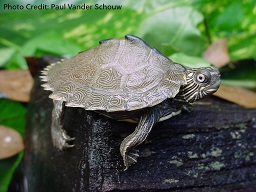Sabine Map Turtle (Graptemys sabinensis)
Taxom: * * In recent years the Sabine map turtle (Graptemys ouachitensis sabinensis) has been recognized by many as a full species Sabine map turtle (Graptemys sabinensis).
Description: This species' carapace features a row of low vertebral spines, and is serrated on the posterior rim. The carapace is olive, dark brown, or black in coloration with light yellowish markings with dark borders. The plastron color varies from cream to yellow and is patterned with dark lines and swirls. The body color is grayish brown to blackish and is marked with yellowish stripes.
On the head, it has light yellow spots: a rectangular one behind each eye, an oval under each eye, and a round one on each side of the jaw. In some specimens, the spot behind and the spot under the eye can combine to form a single thick "C" stain. The eye has a black stripe in the middle.
Males are significantly smaller than females. The males can grow to be as large as 5 inches in carapace length. The females can grow to be up to 10 inches in carapace length.
Habitat: Rivers, creeks, and associated oxbows, lakes, and swamps; favors areas with logs and aquatic vegetation.
Range: This species is endemic to the United States. G. o. sabinensis exists only in the Sabine River of Louisiana and Texas.
Found in these States:
LA |
TX
Diet: Sabine map turtles feed mainly on small aquatic animals such as shrimp, insects, molluscs, and fish. They also consume algae and aquatic plants.
Reproduction: Males are sexually mature at a minimum PL of approximately 2.4 inches, which they typically reach by the time they are 3 years old in the wild. Females mature at a PL around 5.9 to 6.3 inches, which may require as many as 6-7 years to reach. Captive specimens tend to grow and mature more quickly due to a nearly year-round growing season.
Status: Vulnerable in its entire distribution.
»» Kingdom: Animalia - Animals
»» Phylum: Chordata - Chordates
»» Subphylum: Vertebrata - Vertebrates
»» Class: Reptilia - Reptiles
»» Order: Testudines - Turtles & Tortoises
»» Family: Emydidae - Pond, Marsh, & Box Turtles
»» Genus: Graptemys
»» Species: Graptemys sabinensis - Sabine Map Turtle
»» Subspecies: None
This article uses material from the Wikipedia article "Ouachita Map Turtle", which is released under the Creative Commons Attribution-Share-Alike License 3.0. Content may have been omitted from the original, but no content has been changed or extended.
|








